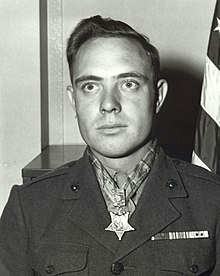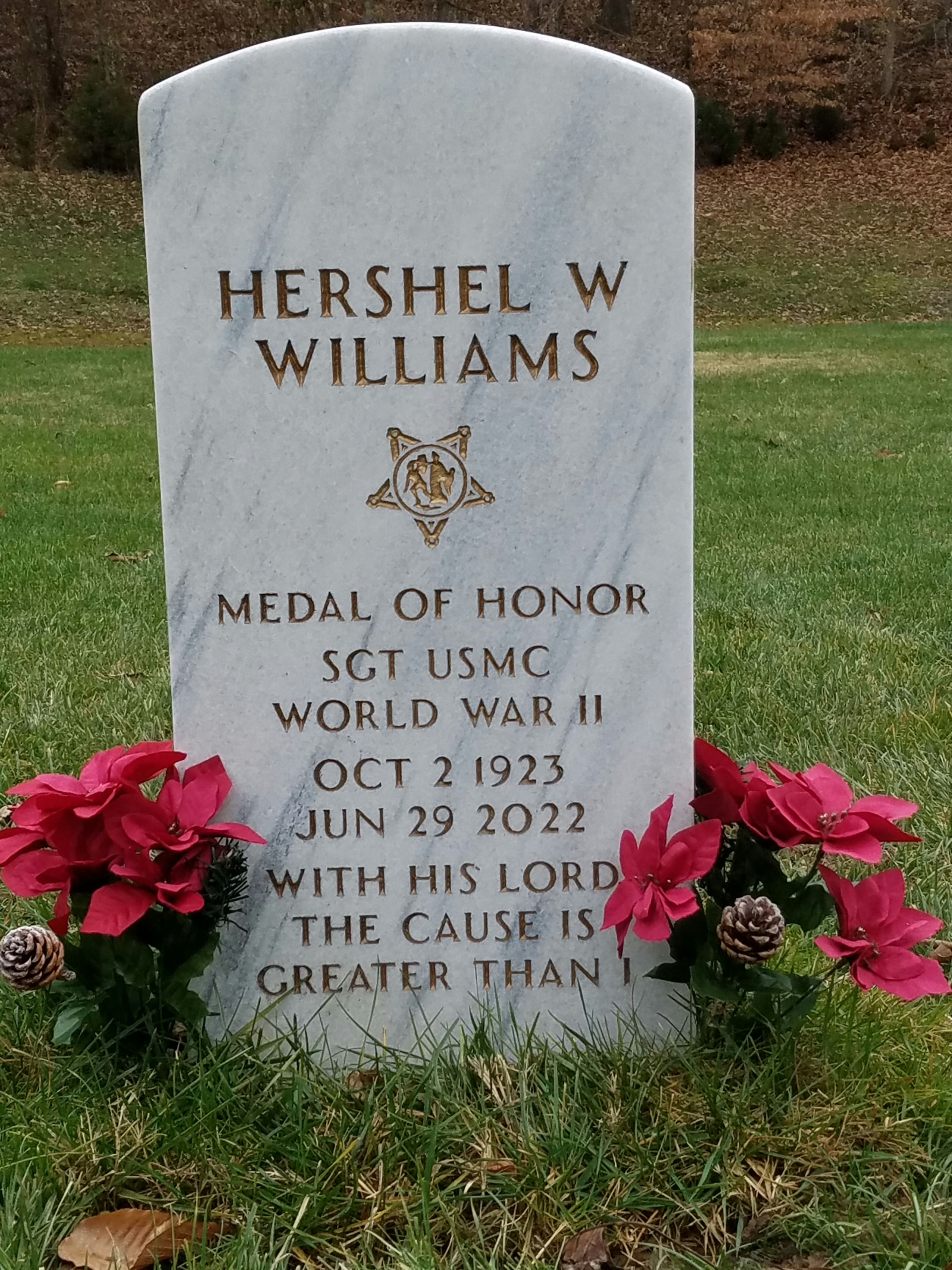b. 02/10/1923 Quiet Dell, West Virginia. d. 29/06/2022 Huntington, West Virginia.
DATE OF MOH ACTION: 23/02/1945 Iwo Jima, Japan.
Williams, the youngest of eleven children, was born in Quiet Dell in Marion County, West Virginia, southeast of Fairmont, on October 2, 1923, and raised on a dairy farm in the area. At birth, Williams weighed 3+1⁄2 pounds and was not expected to live. His mother, Lurenna, decided to name him after the doctor who arrived at their farm several days after his birth. By the time he was 11, his father, Lloyd, had died of a heart attack and several of his siblings had died due to the flu.
Williams worked a series of odd jobs in the area, including as a truck driver for W.S. Harr Construction Company of Fairmont, and as a taxi driver. When Pearl Harbor was attacked, he was working in Montana as a Civilian Conservation Corps enrollee.
Williams was drawn to the Marines by their dress blue uniforms he had seen several men in his community wear. He disliked the Army’s brown wool uniform he considered “… the ugliest thing in town … I decided I did not want to be in that thing. I want to be in those dress blues.” Aside from the appearance of the uniform, Williams knew nothing of the Marines. Standing 5-foot-6, when Williams tried to enlist in the Marine Corps in 1942, he was told he was too short for service. After the height regulations were changed in early 1943, he successfully enlisted in the United States Marine Corps Reserve in Charleston, West Virginia, on May 26.
Williams received his recruit training at Marine Corps Recruit Depot San Diego, California. Upon completion, he was sent to the Camp Elliott training center in San Diego, where he joined the tank training battalion on August 21, 1943. The following month he was transferred to the training center’s infantry battalion for instruction as a demolition man and in the use of flamethrowers. The training, Williams said, was technical and focused on the flamethrower’s design: three tanks, two of which held a mix of diesel fuel and aviation gas, and a third tank that held compressed air. There was little training on the operational use of the weapon. “We had to learn that ourselves”, he said.
Williams was assigned to the 32nd Replacement Battalion on October 30, 1943, and left for New Caledonia in the southwest Pacific on December 3 aboard the M.S. Weltey Reden. In January 1944, he joined Company C, 1st Battalion, 21st Marine Regiment, 3rd Marine Division at Guadalcanal. In July and August 1944, he was attached to Headquarters Company and participated in action against the Japanese during the Battle of Guam. In October, he rejoined Company C.
Williams’ next and final campaign was at the Battle of Iwo Jima, where he distinguished himself with actions “above and beyond the call of duty”, for which he would be awarded the Medal of Honor. On February 21, 1945, he landed on the beach with the 1st Battalion, 21st Marines. Williams, by then a corporal, distinguished himself two days later when American tanks, trying to open a lane for the infantry, encountered a network of reinforced concrete pillboxes.
Pinned down by machine-gun fire, his company commander asked one of his men to attach a high explosive charge to a pole and, supported by Williams, his flamethrower and several Marine riflemen, shoved the improvised weapon into an opening in the enemy’s pillbox. As they fought their way to the pillbox, all of the men, except Williams, became casualties. Undeterred, Williams arrived at the first pillbox, shoved the flamethrower nozzle into the pillbox opening and fired the weapon, killing all of the soldiers inside. He then returned five times to his company area, refuelled his weapon, and moved forward to destroy the remaining pillboxes.
Covered by only four riflemen, he fought for four hours under intense enemy small-arms fire and repeatedly returned to his own lines to prepare demolition charges and obtain serviced flame throwers. He returned to the front, frequently to the rear of hostile emplacements, to wipe out one position after another. At one point, a wisp of smoke alerted him to the air vent of a Japanese bunker, and he approached close enough to put the nozzle of his flamethrower through the hole, fire and kill the occupants. On another occasion, he was charged by enemy riflemen who attempted to stop him with bayonets; he fired at them with a burst of flame from his weapon and in a PBS America documentary “The Seabees on Iwo Jima” recounted how “It took all the oxygen from them…” which killed them. Williams said that much of the action “is just a blank. I have no memory.”
These actions occurred on the same day that two flags were raised on Mount Suribachi, and Williams, about one thousand yards away from the volcano, was able to witness the event. He fought through the remainder of the five-week-long battle, even though he was wounded in the leg on March 6 by fragmentation, for which he was awarded the Purple Heart.
In September 1945, he returned to the United States, and on October 1 he joined Marine Corps Headquarters in Washington, D.C. He and thirteen other servicemen were presented the Medal of Honor by President Harry S. Truman on October 5, 1945, at the White House.
On October 22, 1945, he was transferred to the Marine Barracks, Naval Training Center Bainbridge, Maryland, for discharge. He was honorably discharged from the Marine Corps Reserve on November 6, 1945.
In March 1948, he reenlisted in the inactive Marine Corps Reserve, but was again discharged on August 4, 1949.
On October 20, 1954, he joined the Organized Marine Reserve when the 98th Special Infantry Company was authorized by Headquarters Marine Corps to be located at Clarksburg, West Virginia. He transferred to the Marine Corps Reserve’s 25th Infantry Company in Huntington, West Virginia, on June 9, 1957, later becoming the (Interim) Commanding Officer of that unit as a warrant officer on June 6, 1960. He was designated the Mobilization Officer for the 25th Infantry Company and surrounding Huntington area on June 11, 1963.
He was advanced through the warrant officer ranks during his time in the Marine Corps Reserve until reaching his final rank of Chief Warrant Officer 4. Although Williams technically did not meet retirement requirements, he was honorarily retired from the Marine Corps Reserve in 1969 after approximately 17 years of service. After World War II, Williams served as a United States Department of Veterans Affairs veterans service representative, retiring after 33 years federal service.
Williams died at the Hershel “Woody” Williams Veterans Affairs Medical Center in Huntington, West Virginia, on June 29, 2022, at the age of 98. He was the last surviving Medal of Honor recipient from World War II. On July 14, 2022, Williams’ remains lay in honor at the U.S. Capitol Rotunda.
MOH CITATION:
For conspicuous gallantry and intrepidity at the risk of his life above and beyond the call of duty as demolition sergeant serving with the 21st Marines, 3d Marine Division, in action against enemy Japanese forces on Iwo Jima, Volcano Islands, 23 February 1945. Quick to volunteer his services when our tanks were maneuvering vainly to open a lane for the infantry through the network of reinforced concrete pillboxes, buried mines, and black volcanic sands, Cpl. Williams daringly went forward alone to attempt the reduction of devastating machine-gun fire from the unyielding positions. Covered only by four riflemen, he fought desperately for four hours under terrific enemy small-arms fire and repeatedly returned to his own lines to prepare demolition charges and obtain serviced flamethrowers, struggling back, frequently to the rear of hostile emplacements, to wipe out one position after another. On one occasion, he daringly mounted a pillbox to insert the nozzle of his flamethrower through the air vent, killing the occupants, and silencing the gun; on another he grimly charged enemy riflemen who attempted to stop him with bayonets and destroyed them with a burst of flame from his weapon. His unyielding determination and extraordinary heroism in the face of ruthless enemy resistance were directly instrumental in neutralizing one of the most fanatically defended Japanese strongpoints encountered by his regiment and aided vitally in enabling his company to reach its objective. Cpl. Williams’ aggressive fighting spirit and valiant devotion to duty throughout this fiercely contested action sustain and enhance the highest traditions of the U.S. Naval Service.
BURIAL LOCATION: DONEL C. KINNARD MEMORIAL STATE VETERANS CEMETERY, DUNBAR, WEST VIRGINIA.
SECTION 2, SITE 129.
LOCATION OF MEDAL: FAMILY.


